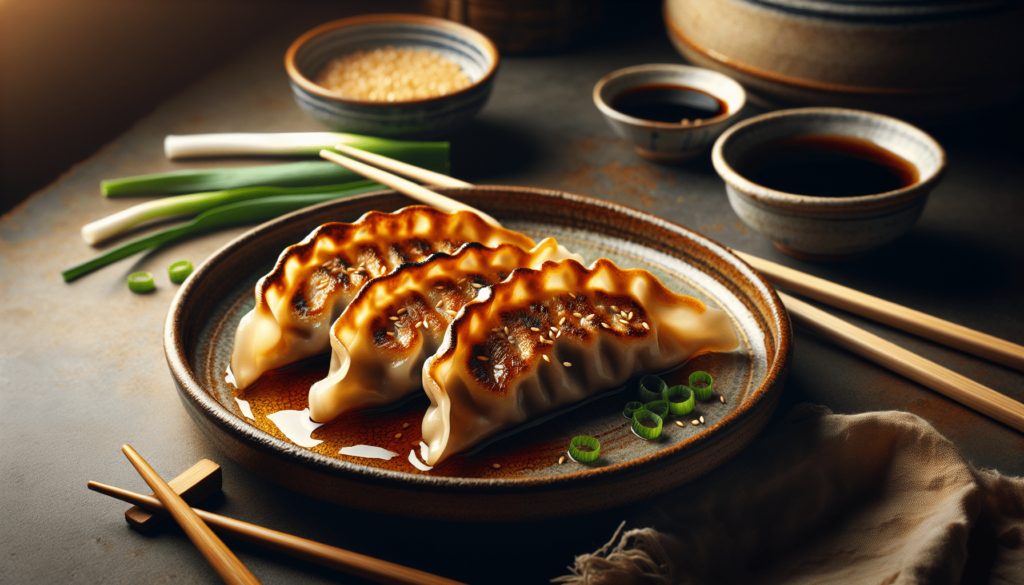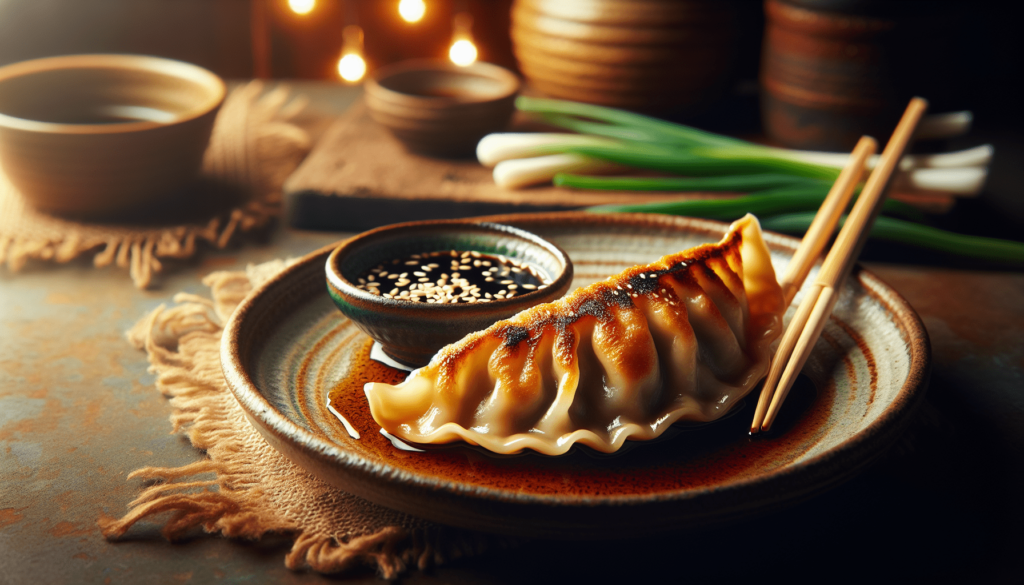Have you ever wondered how to make those mouthwatering gyoza dumplings you enjoy so much at your favorite restaurant? You’re in luck! Today, we’ll journey through the steps to create an authentic gyoza recipe right in your own kitchen. Cooking gyoza may seem complicated at first, but with the right guidance and a bit of practice, you’ll be a gyoza master in no time. Let’s walk through each element of this delicious dish and explore how you can perfect it.
What is Gyoza?
Gyoza is a type of Japanese dumpling that is wildly popular both in Japan and around the world. These delightful parcels consist of a savory filling wrapped in a thin dough, typically pan-fried on one side to create a crispy bottom while the other side is steamed to keep it tender and juicy.
Origin of Gyoza
While gyoza is a beloved Japanese dish, it’s inspired by the Chinese dumpling known as “jiaozi.” The Japanese version has grown to have its own distinct character and flavor that sets it apart. Introduced to Japan post-World War II, gyoza quickly became a popular comfort food due to its deliciousness and the availability of ingredients.
Types of Gyoza
Did you know there are several types of gyoza? While the traditional pan-fried version is the most common, others worth trying include:
- Yaki Gyoza: Pan-fried gyoza, usually what you find in Japanese restaurants.
- Sui Gyoza: This version is boiled instead of fried, offering a softer texture.
- Age Gyoza: Deep-fried gyoza, providing an extra crunchy exterior.
Ingredients You Will Need
Before we begin, let’s make sure you have all the ingredients needed for a basic yet delicious gyoza filling. Gather these to ensure smooth cooking:
| Ingredient | Quantity |
|---|---|
| Ground pork | 250 grams |
| Napa cabbage | 150 grams, finely chopped |
| Garlic chives | 2 tablespoons, chopped |
| Ginger | 1 teaspoon, grated |
| Garlic | 2 cloves, minced |
| Soy sauce | 1 tablespoon |
| Sesame oil | 1 tablespoon |
| Salt | ½ teaspoon |
| Pepper | ¼ teaspoon |
| Gyoza wrappers | Around 30 pieces |
| Vegetable oil | For frying |
| Water | ¼ cup |
Substitutions and Additions
Feel free to adjust the recipe based on your taste preferences or dietary needs. For example:
- Protein: Swap pork for chicken, shrimp, or make it completely vegetarian by using tofu.
- Vegetables: Experiment with different vegetables like mushrooms, carrots, or scallions.

Preparing the Gyoza Filling
The heart of any gyoza lies in its filling. Crafting a well-balanced filling will take your dumplings from good to unforgettable.
Step 1: Prepare the Vegetables
Start by finely chopping the napa cabbage and garlic chives. You want them to be small so they mix well with the pork and offer consistent texture and flavor in each bite.
Step 2: Mixing the Ingredients
In a large bowl, combine the ground pork, chopped vegetables, and all seasonings—garlic, ginger, soy sauce, sesame oil, salt, and pepper. Use your hands to mix these components thoroughly—this helps to bind the mixture and ensure every gyoza is packed with flavor.
Step 3: Rest the Mixture
Once combined, let the mixture rest. This step is crucial as it allows the flavors to meld, resulting in a more flavorful filling.
Wrapping the Gyoza
Here’s where the fun begins! Wrapping the gyoza takes a bit of practice, but once you get the hang of it, it can be quite rewarding.
Step 1: Prepare Your Wrapping Station
Set up a clean workspace and get a small bowl of water ready. You will use this to moisten the edges of the gyoza wrappers, which helps seal them.
Step 2: Filling the Wrappers
Take one gyoza wrapper and lay it in the palm of your hand. Spoon about a teaspoon of filling into the center of the wrapper. Be careful not to overfill, as this will make sealing difficult.
Step 3: Sealing the Dumplings
Moisten the edges of the wrapper using your finger dipped in water. Fold the wrapper in half over the filling and pinch at the top to make a pleat. Continue pleating one side while pressing it against the other side, creating a series of folds until it is completely sealed.
Practice Makes Perfect
Don’t be discouraged if your first few gyoza aren’t perfect. Like any new skill, folding gyoza takes some practice. Soon enough, you’ll be folding like a pro.

Cooking the Gyoza
Cooking gyoza is a two-step process that gives them their signature crispy bottom and tender top.
Step 1: Frying
In a non-stick skillet, heat a small amount of vegetable oil over medium-high heat. Place the gyoza in the pan, ensuring they aren’t touching each other. Fry for 2 to 3 minutes, or until the bottoms are golden brown.
Step 2: Steaming
Carefully add ¼ cup of water to the pan and immediately cover with a lid. It’s important to work quickly here to prevent oil splattering. The steam cooks the tops of the gyoza, keeping them moist and juicy. Let them steam for about 4 minutes, or until the water has evaporated.
Step 3: Uncover and Crisp
Remove the lid and allow the gyoza to fry for another couple of minutes to ensure the bottom is crisped again. Once done, remove from the pan and serve immediately.
Serving Your Gyoza
Generally, gyoza is enjoyed right out of the pan when they’re at their warmest and crispiest. You can serve them as an appetizer or as the star of your meal.
Dipping Sauce
Gyoza pairs perfectly with a simple dipping sauce. Here’s a quick recipe you can whip up:
| Ingredient | Quantity |
|---|---|
| Soy sauce | 2 tablespoons |
| Rice vinegar | 1 tablespoon |
| Chili oil | ½ teaspoon (optional) |
Mix these ingredients in a small bowl. Feel free to add a touch of sugar if you prefer a sweeter sauce or more chili oil for spice.
Garnishing
For an extra touch of flavor and color, consider garnishing your gyoza with thinly sliced green onions or sesame seeds.
Tips and Tricks for Perfect Gyoza
To ensure your gyoza always turns out fantastic, here are some insider tips:
- Avoid Overfilling: This will make them difficult to seal and prone to bursting.
- Keep Wrappers Moist: Cover unused wrappers with a damp towel to prevent them from drying out.
- Achieve Crispy Bottoms: Ensure the pan is hot before adding the gyoza for a nice golden crust.
Storing and Reheating Gyoza
If you have leftovers or want to prepare gyoza ahead of time, here’s how you can store and reheat them:
Freezing
Arrange uncooked gyoza on a baking sheet, not touching, and freeze until solid. Transfer them to a ziplock bag. They can be cooked straight from the freezer, though you’ll need to add more steaming time.
Reheating
For already cooked gyoza, it’s best to reheat them in a pan to regain their crispiness. Avoid using a microwave, as it can make them soggy.
Conclusion
With this guide in your culinary arsenal, you’re fully equipped to make irresistible gyoza that’ll impress any dumpling lover. Remember, the key lies in savoring the process of preparing, cooking, and, most importantly, enjoying the delicious fruits of your labor. Whether you’re making them for a small meal or a large gathering, these Japanese dumplings are sure to delight everyone around your table. Now it’s your turn—get your ingredients ready and let the gyoza-making adventure begin!
Some of the links on this site are affiliate links, which means I may earn a small commission if you click on them and make a purchase, at no additional cost to you. As an Amazon Associate, I earn from qualifying purchases.



